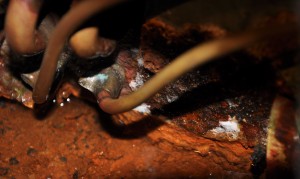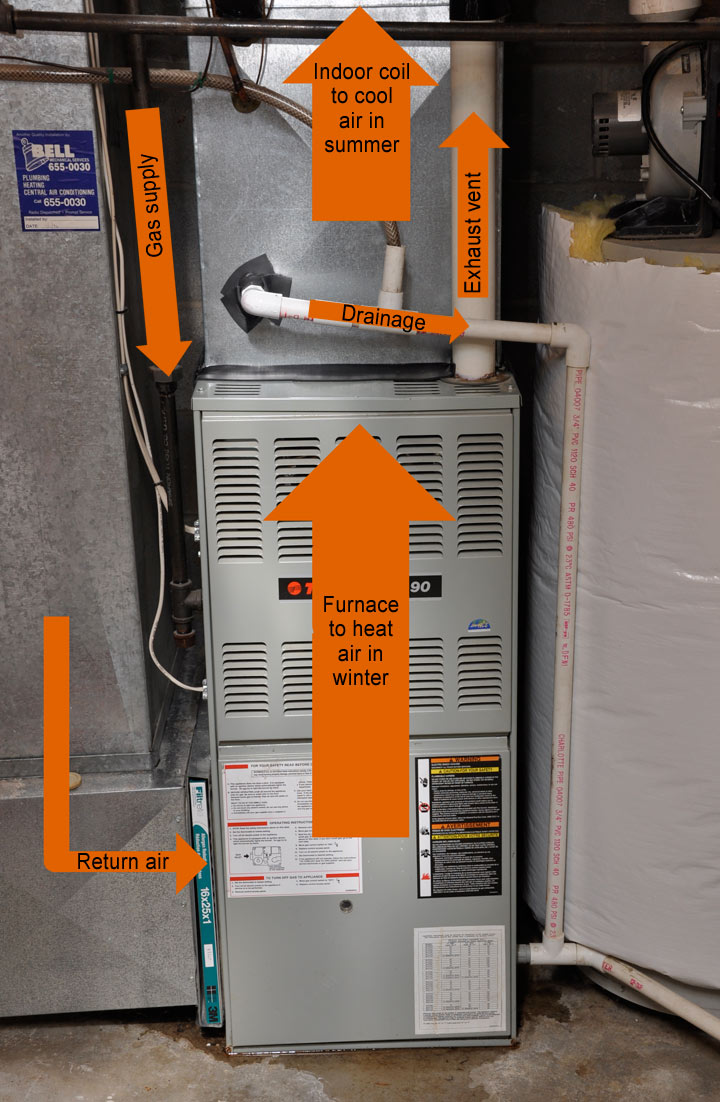
All my recent indoor HVAC problems started with one little symptom. There was a tiny bit of water pooling in front of my furnace. If you have a similar problem, it doesn’t necessarily mean costly repairs, but you should act sooner than later.
Diagram of Indoor HVAC System
It’s important to understand the different parts of your HVAC system before you begin poking around. You don’t want to accidentally make any problems worse. Here’s a labeled picture mapping out the main parts, using my HVAC system as an example. Arrows indicated the direction of flow.
Air flows from the house into the air return. This air travels past burners (to heat air in colder months) and an indoor air-conditioning coil (to cool air during warmer months), then back out through duct-work to different parts of your home. My home features a gas furnace and has gas supply lines. Electric heaters won’t have these gas lines.
Water Pooling from HVAC
You can see in the picture a small pool of water on the concrete slab just in from of the furnace. It’s not much water but after removing the front access panels I could see more water leading all the way up to the indoor AC coil. I speculated that the leak was condensation that wasn’t making it out through the drainage pipe.
Fix a Clogged HVAC Drainage Pipe
Most HVAC issues are not really within the realm of most do-it-yourselfers and I strongly recommend hiring a contractor. Better yet, make a friend in the HVAC business. These are the steps I followed with the help of a buddy.
 Open up any access panels and check internal drainage lines. They are probably flexible tubing with plastic collars securing them in place. Makes sure all the lines are well-connected and feel around for any drips. If you don’t find anything amiss, you may have a clogged drainage pipe.
Open up any access panels and check internal drainage lines. They are probably flexible tubing with plastic collars securing them in place. Makes sure all the lines are well-connected and feel around for any drips. If you don’t find anything amiss, you may have a clogged drainage pipe.- Your drainage pipe is probably PVC. Setup a pan below and cut the line. Make a smooth, clean cut in a place that you can repair later. Straight-aways are best because you can glue a PVC sleeve around both sides restoring the line.
- Examine what (if anything) comes out. If water rushes out, the clog may be farther down. You can attempt to “snake” the line or swap it out. PVC is inexpensive making it easy to simply replace the rest of your drainage line.
- In my case, a small trickle of water came out, meaning the clog was further up the line. We used a bent coat hanger to poke around and dislodge the clog. Be very careful not to damage your coil. The coat hanger worked well and a lot of water poured out.
- I love using my flexible fiberscope and this was a perfect opportunity. I fed the scope in and looked around. We discovered a lot of rust! Small chunks were actually clogging the drainage line causing water to pool (and ultimately find another way out).
Indoor Air Conditioning Coil Drainage Pan
Your indoor air conditioning coil sits on an angled pan. This pan collects condensation and directs it to the drainage line. Gravity takes effect and the water goes about it’s merry way. Over time, my pan lost it’s angle allowing water to pool. It still drained but only when the water level got high enough. This went on long enough for my coil to rust and ultimately cause the clog.
What do you think? Ever work on your HVAC system?








Hey Ethan,
This is very timely. We also have a leak by our HVAC system. It’s coming from a copper pipe which we think is the drainage pipe and we are able to get a bucket under it and know exactly where it’s coming from. I’m a little nervous to work with the copper pipe ourselves though, since it’s not as easy to repair as PVC. Do you have a recommendation of who to call?
Beth
@Beth,
You can use a repair clamp to fix small leaks in copper pipe. If the leak is a sign of bigger problems, I can get you the name and number for my HVAC buddy.
I believe the line labelled as “Pressure release” in this picture is actually the exhaust vent for the gas. Electric furnances won’t have this either. In older furnaces, it will likely be a larger vent made of sheet metal.
@Greg, Thanks for catching that. I’ll update the picture.
water leaking out of the air return on my carpet. What could be the problem? Notice that it stops cooling the house then it starts to work again but dumps water on carpet.
Absolutely! A clogged condensate drain line is the most common cause of water leaking from your AC into your home. If the drain line gets clogged with dust, dirt, sludge or mold, that water backs up into your home.